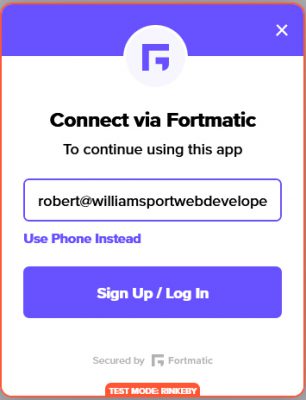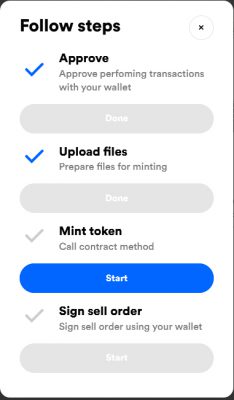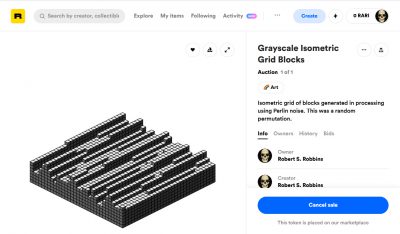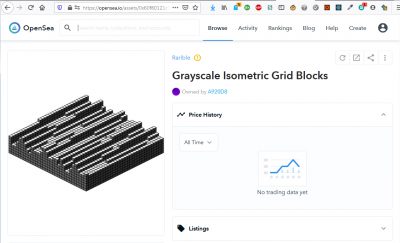I am now interested in non-fungible tokens as a way to market my digital art. I have been creating digital art using Processing, the computer programming language for creating art. The type of art you can create is mostly geometric art or generative art. Some abstract art can be recreated if it is essentially geometric in design. The problem with digital art is that you cannot sell it to art collectors because there is no physical manifestation of the art work. All you can offer is an image file and an image file is not unique. You can copy an image file endlessly. I have thought about creating hardware to display my digital art like an Arduino with a TFT LCD screen or a Raspberry Pi with an e-Ink display. This would serve as a particular physical manifestation of the art work. Unfortunately LCD screens and e-Ink displays are not canvas sized. A lot of the displays for Arduino and Raspberry Pi are tiny.
Non-fungible tokens solve this problem by associating digital art with a token on a blockchain. These digital tokens are unique and can signal ownership of an asset. Although an image file of digital art can be reproduced by anyone, the token ensures that only one person actually owns the digital art as an asset.
Virtual art work has several advantages over physical art work. You don’t have to worry about storing the art work so that it will not be damaged. You don’t have to insure the art work. I once bought an expensive numbered print which was damaged in a flood. I had to throw it out. This will never happen with a NFT. Digital art work can be loaned to a museum without paying for shipping or insurance. The museum simply needs a digital display on which to display the image file you send them. The NFT ensures that they are displaying the “original” even though they are just displaying a copy of an image file. There are now art museums in virtual worlds which display virtual art and the art work is certified as the real deal by the NFT.
Non-fungible tokens allow anyone to become an art collector even if they don’t have the storage space or the insurance to collect fine art. I have bought some interesting art work on eBay which might even be worth something. But often I don’t know what artist created the piece or the provenance of the piece. I don’t even know if I own original art or just a print. A NFT solves this problem because the entire history of the art work is on the blockchain. You will know who created the NFT and how often the token has changed hands. This means any art work associated with a NFT has a well documented provenance. Some smart contracts for NFTs even create a royalty so any subsequent exchange of the asset pays a royalty back to the creator or artist. So let’s say you are a starving artist and you sell a digital painting for $5.00 as a NFT. Decades later you are a famous artist and your NFT is sold to an art museum for 10 million dollars. You would receive a percentage of that sale!
To create a NFT you must mint a token. I found this process to be more complicated and expensive than I was expecting. I minted a token on Rarible, a marketplace for NFTs. To create a NFT on Rarible you must first connect a wallet. You will need a web3 wallet like Metamask or Fortmatic. So the first hurdle is signing up for one of these wallets. I used Fortmatic because I found their API which I tried out a bit. Your wallet will need some Ethereum. You cannot buy Ethereum with a credit card so that is another hurdle. I can purchase Ethereum on Coinbase which is connected to my bank account. After purchasing the Ethereum on Coinbase you need to send it to your Fortmatic wallet. Any sending of crypto on Coinbase requires entering a code which is sent via SMS to your smartphone. So another hurdle is that you need a smartphone with a service plan that includes text messages.
After you manage to get some Ethereum into your Fortmatic wallet you head on over to Rarible and press the connect wallet button. Then you go through the process of connecting via Formatic which requires your email address, your password, and finally a 6 digit code emailed to your email address. This is what I found so complicated! Several times I had to wait for codes to be delivered. I did not have enough Ethereum in my Fortmatic wallet so I had to do this twice. Even after all this there were many steps to follow on Rarible including; approve performing transactions with my wallet, uploading the image file, minting the token, and signing the sell order using my wallet. The fee to mint the token was 0.032628 ETH or around $48.00. This expense is known as the Ethereum gas fee and you must pay it to conduct a transaction or execute a contract on the Ethereum blockchain platform.
My first NFT is an image file of blocks on an isometric grid. The height of the blocks is determined by Perlin Noise. This is a technically sophisticated piece of digital art. The blocks suggest a blockchain. Although the script creates random isometric blocks in hills and valleys, I choose a single instance of its random variations. This image file is now stored on the IPFS (InterPlanetary File System), a peer-to-peer hypermedia protocol designed for sharing image files in a distributed way. This ensures that the image file can always be found. It does not just live on a web server which might disappear some day. You can view my NFT on Rarible at https://app.rarible.com/token/0x60f80121c31a0d46b5279700f9df786054aa5ee5:202348:0xa920d82179d47afaa1f5ab322368a606e1a4af35 where you can place a bid. If I accept your bid you become the new owner of the NFT and are on your way as an art collector building a collection of virtual fine art. Notice that 10% of sales go to the creator. That means that I get 10% of all subsequent sales of this asset. So it might be in my best interest to accept a low bid just to get the ball rolling. A NFT with a history of changing hands might be seen as a good investment. As long as the value of the piece continues to go up my 10% royalty will ensure that I make far more money than the initial low bid I accept.
In addition to appearing on Rarible my NFT also appears on the OpenSea marketplace where it can be found at https://opensea.io/assets/0x60f80121c31a0d46b5279700f9df786054aa5ee5/202348. I must say that the search tools on these NFT markets are terrible since you cannot find my art work using its name “Grayscale Isometric Grid Blocks”. This is pretty annoying because discoverability is very important for artists. A starving artist wants to be discovered and an art collector wants to discover particularly striking art works. It will require additional research to find the starving artists that are trying to sell their work as a NFT. Many NFTs are crappy pieces of artwork that were created as get-rich-quick schemes. They are overpriced and not worth the investment. However you might be able to find genuine pieces of fine art that can be acquired at a bargain. A struggling artist has an incentive to accept a low bid for his NFT because it gets the ball rolling and the art collector is taking a risk with NFTs.
In conclusion creating a NFT cost me around $50 and I spent hours going through the process. I don’t think many starving artists are going to see this as their salvation. But I found it worthwhile since I learned a lot about digital assets on the blockchain. Buying these sort of assets with crypto-currency intrigues me because I think fine art is a better asset for long term investment than the crypto-currency itself. I am also pleased that I have placed my digital art on a legitimate art market. I think that makes me a real artist!






